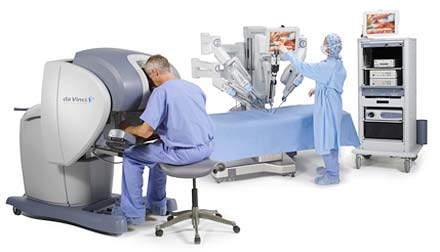The medical profession is no different from a shoe store, a railroad track company, or a financial investment conglomerate which is seeking to expand into international markets and the reason for this is that breakthroughs and developments in technology will be determined by costs and reductions in them. In other words, robotic surgery will save money.
Perhaps the only qualifying statement that can be added to this observation is that ultimately, the medical profession will seek to provide the most cost effective solution to patient care, without ever compromising the actual quality of the care provided.

Robotic Surgery
There has been a great deal of controversy within the medical profession concerning the reliability, cost effectiveness and relevance of robotic surgery. To some medical professionals, it represents nothing more than the “Emperor’s new clothes” syndrome taken to extreme lengths. Or to put it more bluntly, the critics say that progress is made simply for the sake of making progress and that something new is automatically associated as being better.
Others argue that the usage of robotic surgery may still have some teething problems that need to be resolved but ultimately, the technology has a lot of potential and which could radically improve the efficiency and productivity of the profession as a whole.
With that in mind then, the following is a comparison of both the benefits and drawbacks attributed to the usage of robotic surgery.
Benefits of robotic surgery
• The fact that a surgeon will be able to manipulate the robot from a centralized distance means that the surgery can be performed in a less restrictive manner. This means that the patient can be treated and operated on with a minimum of staff which in turn, reduces costs.
• The fact that surgeons can perform surgery from a distance also benefits the quality of healthcare for the patient as they are able to enjoy the reduction in the costs, as well as a greater degree of flexibility in regard to the areas they are can be treated.
• Doctors will tire and become fatigued, which in turn, reduces their concentration and ability to focus. A surgeon who has been working for several hours without a break will find that he will struggle to hold the scalpel steady and so this places considerable strain on the operating surgeon. With robotic surgery this concern is reduced, even eliminated.
• Robotic surgery will allow for a much greater degree of precision and accuracy to be achieved whenever certain types of surgical procedures are being used, such as orthopedic surgery, or neurological.
Disadvantages of robotic surgery
• Currently, the major limiting factor that is stunting the development of robotic surgery is that of “latency” which is the time delay between the instructions issued by the surgeon and the movement of the robot which responds to the instructions. With the current level of technology, the surgeon must be in close proximity.
• Robotic technology is extremely expensive both in terms of capital costs, as well as running expenses and will require the training of specialized personnel to properly repair and care for it. Such expenses may far outweigh any savings earned at the present time.
The last point is true will almost all emerging technologies. When numbers are small, prices are high. With economies of scale however, the price of machinery, maintenance and training will all go down to reasonable levels.
If you’d like a look at other future medical technology then this link will take you to a doorway to the short years ahead of us.
 The human body is composed of elements such as oxygen, carbon, hydrogen, nitrogen, calcium, phosphorous, potassium, sulfur, sodium, magnesium, copper and lithium (more lithium is in the system of those with bipolar disorder).
The human body is composed of elements such as oxygen, carbon, hydrogen, nitrogen, calcium, phosphorous, potassium, sulfur, sodium, magnesium, copper and lithium (more lithium is in the system of those with bipolar disorder).
